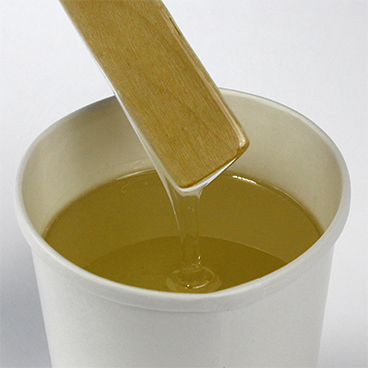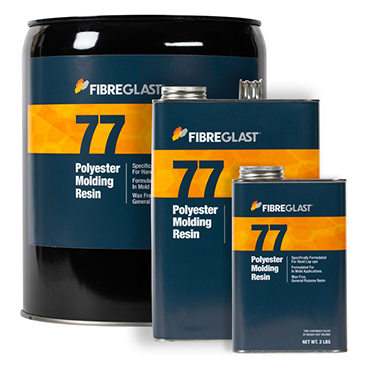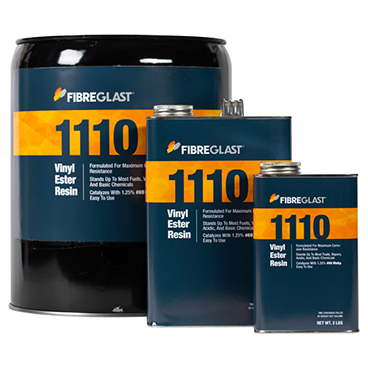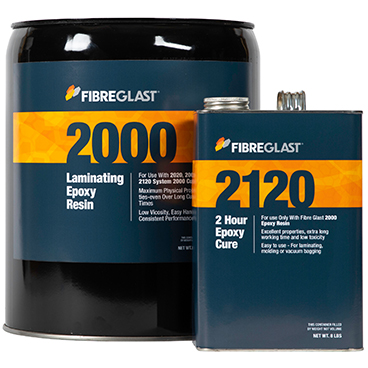Polyester, Vinyl Ester, and Epoxy Resins: Making the Right Choice

Composites are a combination of fiber reinforcements and resin. The physical properties of composites are fiber dominate, meaning that the performance of finished parts is most directly related to that of the reinforcement. So what role does a resin play? This article will answer that and provide a basic understanding of the resin options available at Fibre Glast.
There are a variety of resins on the market for a multitude of uses, including composite laminating resins, floor coating resins, table coating resins and casting resins. For this article we are going to discuss laminating resins since that is the type of resin we sell. Laminating resins begin as a liquid and cure into a solid form.
When combined with a reinforcement fabric, resin serves two primary purposes. First, resin holds the reinforcement fabric together while helping it conform to the desired shape. Without a hardened resin to provide shape, reinforcement fabrics are shapeless and can easily be separated. Second, resins help transfer mechanical loads from individual fibers or fiber bundles across the entire part. While the reinforcement fibers provide the primary strength for a laminate, the role of the resin, transferring that load to across an array of fibers, is also paramount to the overall strength and stability of a part.
For composite laminates, there are three main types of resins used in the production of both parts and molds: polyester, vinyl ester, and epoxy. At Fibre Glast, we carry a selection of each type of resin and each has its own set of benefits and drawbacks that should be considered before starting any project.
 The majority of all fiberglass parts are constructed using polyester resins, it's the most widely used type of resin in the composites industry. Polyester resins require a catalyst to cure or harden, typically methyl ethyl ketone peroxide (MEKP). They are naturally UV resistant, generally viewed as easy to use, fast curing, tolerant of temperature and catalyst variations, and they are less expensive than epoxy systems. Many view polyester resins as being easy to use because they have a high thixotropic index, basically they do a good job clinging to vertical surfaces so the resin won't run or drip as much when making parts and molds. They also wet-out fabrics quickly and easily and they are easy to mix. As the most common resin type in the industry, it can be difficult to narrow down a list of common uses. That said, you can expect to find polyester resins used in the marine industry, used for boat hulls and other applications, they are used for general part fabrication, automotive applications, and for low-cost molds.
The majority of all fiberglass parts are constructed using polyester resins, it's the most widely used type of resin in the composites industry. Polyester resins require a catalyst to cure or harden, typically methyl ethyl ketone peroxide (MEKP). They are naturally UV resistant, generally viewed as easy to use, fast curing, tolerant of temperature and catalyst variations, and they are less expensive than epoxy systems. Many view polyester resins as being easy to use because they have a high thixotropic index, basically they do a good job clinging to vertical surfaces so the resin won't run or drip as much when making parts and molds. They also wet-out fabrics quickly and easily and they are easy to mix. As the most common resin type in the industry, it can be difficult to narrow down a list of common uses. That said, you can expect to find polyester resins used in the marine industry, used for boat hulls and other applications, they are used for general part fabrication, automotive applications, and for low-cost molds.
While these positives obviously weigh in polyester's favor in many applications since it is so widely used, there are a few drawbacks which must also be considered. For one, polyester does not offer as much corrosion resistance as vinyl ester resins, or as much ultimate strength as epoxy resins. Also, thin applications of polyester resin can remain tacky when exposed to the air. We recommend adding Styrene Wax to your resin for thinner layers. The wax rises to the surface and provides a barrier to the air which allows the resin to fully cure. Note, the wax must be sanded and washed off before application of the next coat of resin or paint. If a laminate or mold is constructed using three or more layers of fiberglass reinforcement, no wax is necessary as the heat generated during the cure cycle will fully set the resin.
We have two options for polyester resin, #77 Polyester Molding Resin and #90 Isopthalic Polyester Resin. You can learn more about each of these, including their physical properties and common uses, by visiting the polyester resin category of our website. All of our polyester products are first quality, so you don't have to worry about batch-to batch variations like you would with the lower quality polyester resins you might find at your local hardware store or referred to as"boat resin","mixed resin" or"blended resin". They are also compatible with all of our fabrics, pigments, and fillers.
Tech Tip:
If you want to avoid adding wax to your thin polyester layup or repair, spray PVA mold release over the lamination or repair and the resin will cure tack-free. Wait 25 minutes after finishing the lay-up, then spray on two light coats. Within a few hours, the PVA can be washed off with water, leaving a fully cured resin or gel coat surface.
Polyester Resins
| Item |
Description |
|
| Polyester Molding Resin |
Polyester Molding Resin is a general purpose polyester resin, ideal as a orthophthalic fiberglass resin for part fabrication and for building low cost molds. This resin is easy to work with, less expensive compared to it's epoxy and vinyl ester counterparts, and is wax free, meaning you won't have to sand between coats. |

|
| Isophthalic Polyester Resin |
Isopthalic Polyester Resin is perfect for making dimensionaly stable polyester molds, fabrication of corrosive service parts, and as a durable repair material for tank linings. The Isophtalic Resin boasts much better strength when compared to general purpose polyester resins, which allows it to be used in more demanding applications. |

|
 Vinyl ester resins are often considered a cross between polyester resins and epoxy resins. This is oversimplified, but it does help convey the qualities of the resin. Like polyester resins, they require MEKP as a catalyst to cure or harden. Vinyl ester falls between polyester and epoxy on price, most physical properties, and handling qualities. Vinyl ester resins actually exceed both polyester and epoxy in corrosion resistance, temperature resistance, and elongation (toughness). Because of this, they are typically used when high durability, thermal stability, and extremely high corrosion resistance are needed. These applications often include building and repairing chemical storage tanks. Increasingly the marine industry is exploiting these properties by using vinyl esters to produce and repair fiberglass boat hulls. Vinyl ester boat hulls become nearly impervious to the blistering and osmotic problems commonly encountered when polyester resins are used.
Vinyl ester resins are often considered a cross between polyester resins and epoxy resins. This is oversimplified, but it does help convey the qualities of the resin. Like polyester resins, they require MEKP as a catalyst to cure or harden. Vinyl ester falls between polyester and epoxy on price, most physical properties, and handling qualities. Vinyl ester resins actually exceed both polyester and epoxy in corrosion resistance, temperature resistance, and elongation (toughness). Because of this, they are typically used when high durability, thermal stability, and extremely high corrosion resistance are needed. These applications often include building and repairing chemical storage tanks. Increasingly the marine industry is exploiting these properties by using vinyl esters to produce and repair fiberglass boat hulls. Vinyl ester boat hulls become nearly impervious to the blistering and osmotic problems commonly encountered when polyester resins are used.
Vinyl ester resins are also becoming more commonly used in all areas of modern high performance composites. This is because vinyl ester resins are proving to be a terrific alternative to conventional resins in racing, marine, and aerospace applications.
There are still a few drawbacks to vinyl ester resins. The primary shortcoming is their limited shelf life, many vinyl ester resins only have a 3 month shelf life. This means you typically have to order as needed for a given project rather than stocking up. They are also more expensive than polyester resins and do not offer the ultimate strength that epoxy resins do.
We offer one option, #1110 Vinyl Ester Resin, a pre-promoted version formulated for use with MEKP. It is compatible with all of our fabrics, pigments, and fillers. It is also suitable for construction of most chemical storage and fuel tanks. However, we recommend testing the tank for compatibility before putting it into service.
Vinyl Ester Resin
| Item |
Description |
|
| Vinyl Ester Resin |
Vinyl Ester Resin is considered a hybrid of polyester and epoxy—meaning its handling characteristics, properties, and price generally fall just between the other two. It is important to note that, of the three, vinyl ester resin will provide the highest corrosion resistance, temperature resistance and elongation (toughness). Because of this, they are typically used when high durability, thermal stability, and corrosion resistance is needed. |

|
 Of the three resin types widely used in the composites industry, epoxy offers the highest ultimate strength properties. Epoxies differ from Polyester and Vinyl Ester in that they require a hardener rather than a catalyst to cure. Because of this, epoxies are sometimes offered with a variety of hardener options, allowing you to select the hardener with the pot-life that best fits your project. Epoxy resins also have exceptionally long shelf lives. When you couple their long shelf-life with the variety of hardeners available, you can purchase the resin in bulk and buy the hardener on an as-needed-by-project basis. Epoxy resins offer the strongest bond with reinforcement fabrics, and their excellent strength properties allow them to be used in the lowest-weight parts as well as the most durable molds. Epoxy resin is chosen for its excellent mechanical strength and the dimensional stability it offers, as well as the good chemical and heat resistance with low shrinkage. Epoxy is commonly used in aerospace, racing, military and defense applications.
Of the three resin types widely used in the composites industry, epoxy offers the highest ultimate strength properties. Epoxies differ from Polyester and Vinyl Ester in that they require a hardener rather than a catalyst to cure. Because of this, epoxies are sometimes offered with a variety of hardener options, allowing you to select the hardener with the pot-life that best fits your project. Epoxy resins also have exceptionally long shelf lives. When you couple their long shelf-life with the variety of hardeners available, you can purchase the resin in bulk and buy the hardener on an as-needed-by-project basis. Epoxy resins offer the strongest bond with reinforcement fabrics, and their excellent strength properties allow them to be used in the lowest-weight parts as well as the most durable molds. Epoxy resin is chosen for its excellent mechanical strength and the dimensional stability it offers, as well as the good chemical and heat resistance with low shrinkage. Epoxy is commonly used in aerospace, racing, military and defense applications.
This isn't to say that there are no downsides to epoxy resins. First and foremost, epoxy resins are more expensive than their counterparts. They also require a much more precise, and often complex mix ratio. They are more sensitive to moisture and temperature variation during mixing and layup. This means that epoxy resin is much more suited to use in a professional, climate-controlled environment than it is to an open-air jobsite or garage. Also, once cured parts made with epoxy resin will yellow with UV exposure if not coated with a UV resistant topcoat. Finally, epoxy resins have compatibility considerations. Epoxy resins are not compatible with polyester gel coats as the gel coat will not bond to the epoxy resin. Epoxies are also incompatible with many fiberglass mats, including our chopped strand mat.
We offer a complete line of epoxy resins, ranging from our System 1000 general purpose epoxy resin, to System 2000, a structural aerospace epoxy that offers the highest strength properties available in a room-temperature epoxy. We also have two high temperature epoxies, System 3000, formulated for the production of high temp parts and System 3300, a high temp tooling epoxy that can be used to make exceptionally stable and long-lasting high temperature molds. High temperature epoxy resins are often used for applications that go through heat cycles, or where composites will be exposed to elevated temperatures for extended periods of time. High temperature epoxies require a post-cure at an elevated temperature in order to realize their full temperature resistance properties. Our high temp resins have the benefit of being able to be post-cured unsupported, or off the tool or plug. This allows you to have the benefits of a high temp part or mold, without the expense of a high temp plug or tooling.
Epoxy Resins
| Item |
Description |
|
| System 1000 |
System 1000 has a very low mixed viscosity, making it great for more rapid fabrications. Cured parts will have excellent moisture resistance, making it ideal for construction or repair of boat hulls or other marine applications. System 1000 comes with either a 10 minute pot life or 25 minute pot life hardener. |

|
| System 2000 |
System 2000 is a medium viscosity, light amber laminating resin that is designed to offer the highest ultimate strength for a room temperature epoxy. It is often used for fabricating high strength parts and other demanding structural applications. System 2000 can be paired with a 20, 60, and 120 minute hardener. |

|
| System 3000 |
This High Temp Epoxy kit is engineered to create composite components that will operate in intermediate to high temperature service environments, up to 309°F. |

|
| System 3300 |
For the Highest Performance, High Temperature composite tooling, System 3300 will provide excellent long term service in high temp curing cycle environments. Parts will have a maximum service temperature of 338°F. |

|
Summary
Composites are a growing category, gaining larger acceptance in all types of modern vehicles, structures, and recreational equipment. Understanding the types of resins available and the properties of each type should help you both in the process of product selection and making high performance composites. There are three widely used resin types: polyester, vinyl ester, and epoxy. Fibre Glast has a complete line of laminating resins of each type, all of which are first quality, so you can feel confident that we will stand behind our product.
